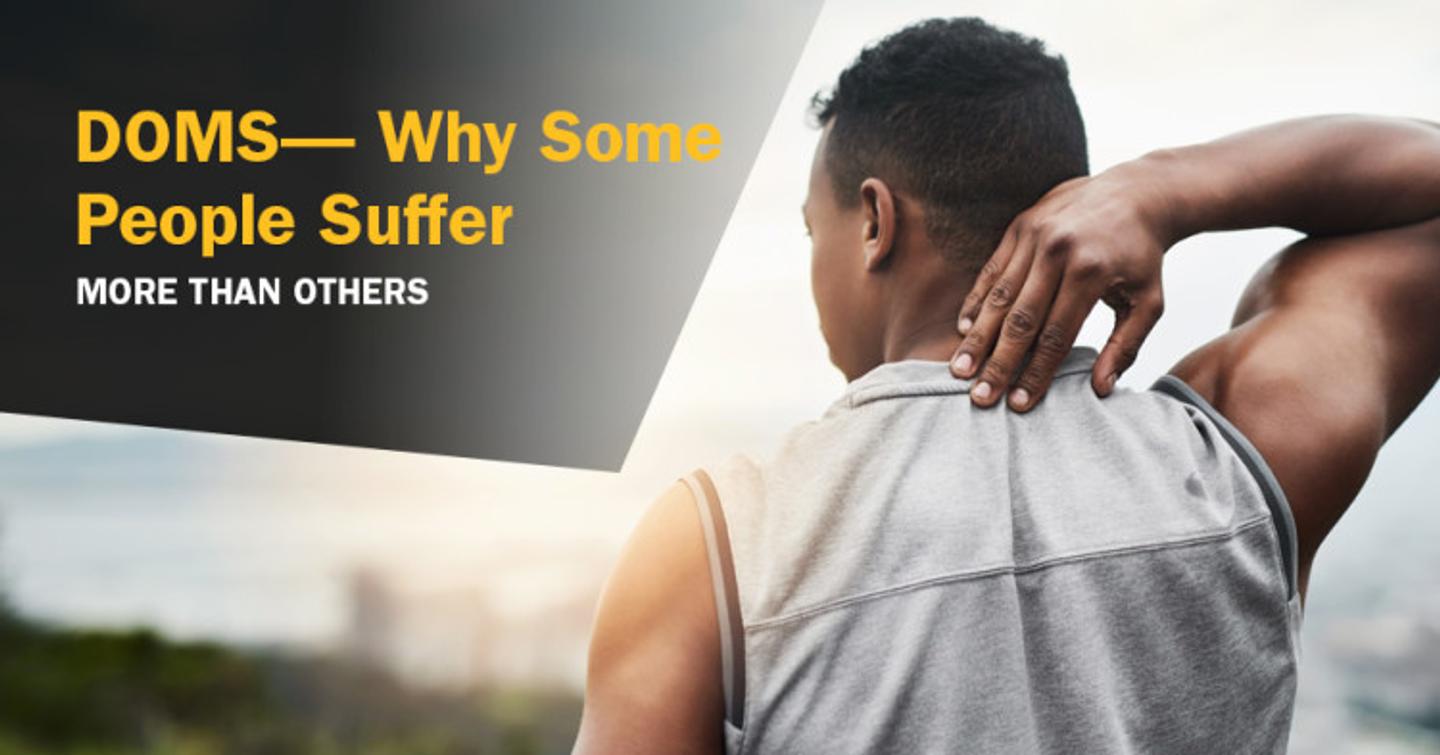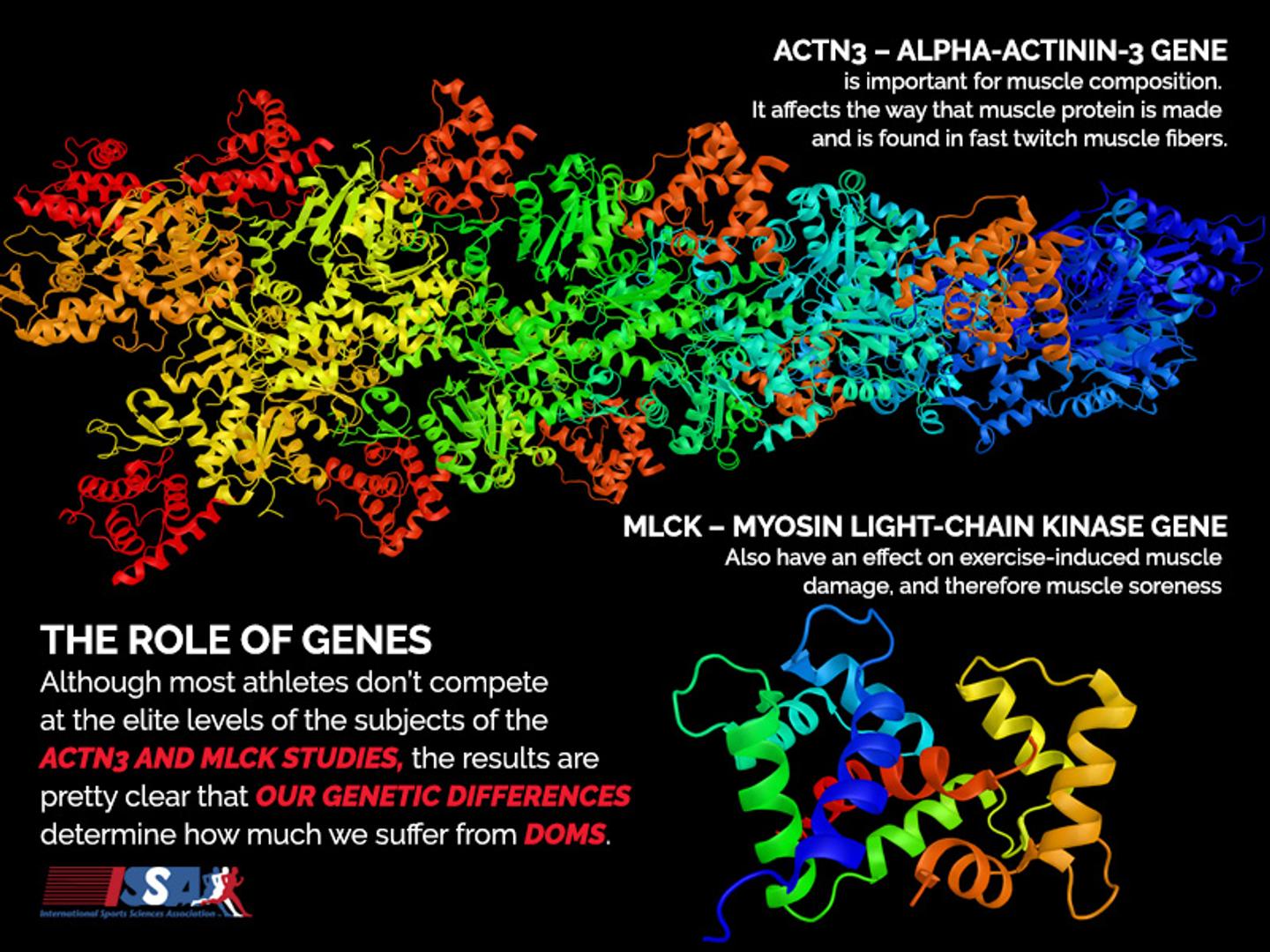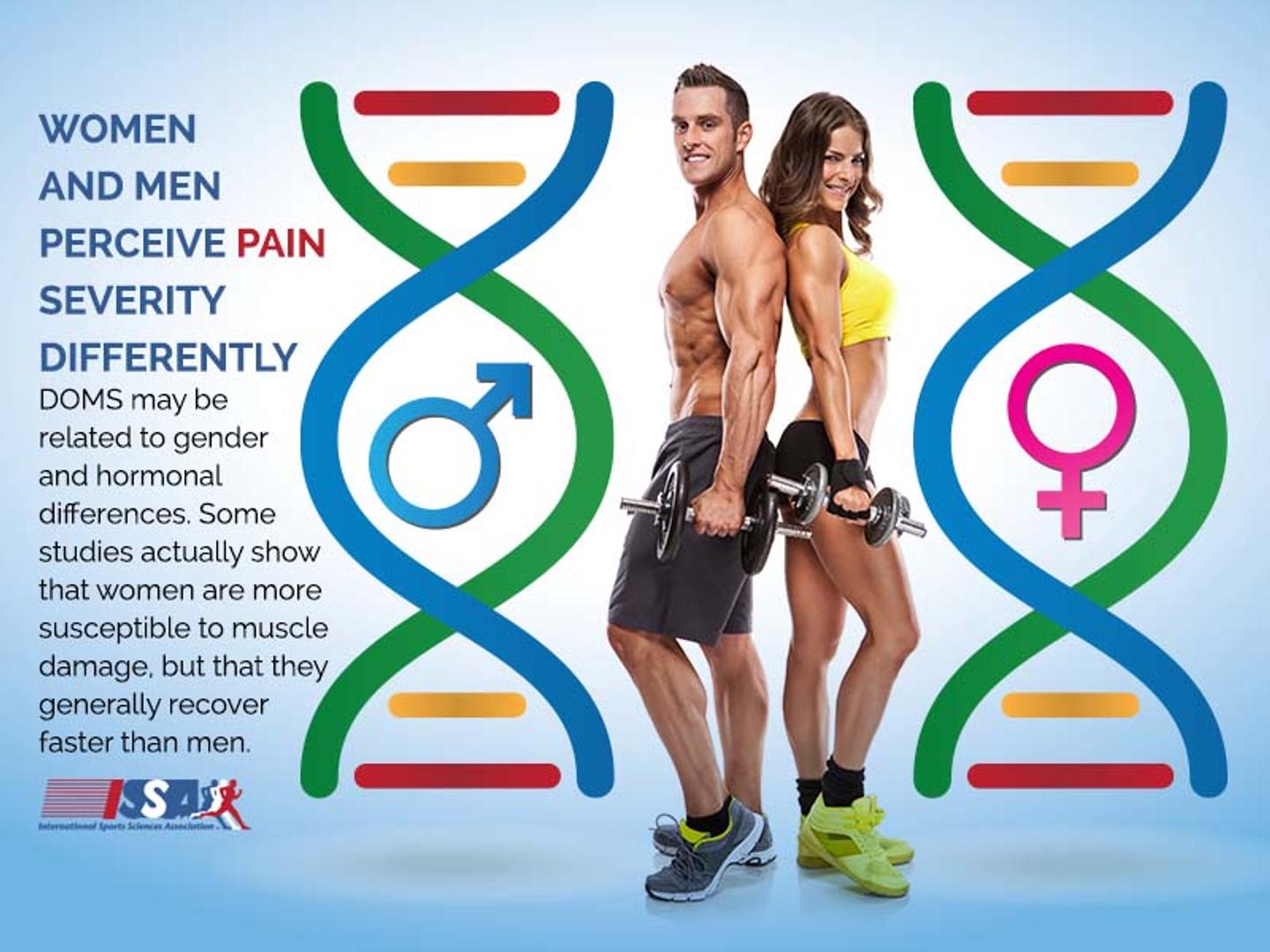
DOMS - Why Some People Suffer More Than Others
Reading Time: 7 minutes 17 seconds
BY: Dominique Groom
DATE: 2022-09-29
DOMS, delayed onset muscle soreness, is a popular fitness topic these days, and the attention focused on it has raised some important questions.
We've all experienced this delayed muscle pain, but some of us seem to get it worse than others. Is it because we're pushing harder with more strenuous exercise? Maybe. But, based on some early research, it seems genes and gender may be the culprits.
First Things First, What is DOMS?
Before we delve into this topic here's a refresher on what DOMS actually is.
DOMS is that pain you sometimes feel a day or two after your workout—in other words, sore muscles. Other DOMS symptoms you might experience include inflammation, muscle stiffness, and decreased muscle strength or muscle function in that area.
Though the exact cause of DOMS hasn't been nailed down yet, researchers have found that it may come from one or more of a few factors:
Performing an unaccustomed movement during your workout
Doing a completely new kind of workout
Increased intensity in your workout
Performing eccentric muscle movements—this is when the muscle lengthens, for example running downhill
There is also some research that indicates the DOMS pain you experience is from little tears in the muscle tissue caused by exercise. In other words, it could be actual muscle damage making you feel the pain a few days later.
Learn more: What is delayed onset muscle soreness and how can you avoid it?
So, is it true that some people are more prone to DOMS than others, or are you just imagining it? There do seem to be some differences, based on genetics and gender, not just the level of strenuous exercise.
The Role of Genes in Muscle Soreness
Studies of genetics, muscle stiffness, and muscle soreness after exercise indicate that genes could play an important role in how sore you get, if at all. There are at least two important genes involved:
ACTN3
MLCK
Each codes for a protein that plays a role in DOMS.

ACTN3 - alpha-actinin-3
The alpha-actinin-3 protein (ACTN3) gene is important for muscle composition. It affects the way that muscle protein is made and is found in fast twitch muscle fibers. Fast twitch muscle fibers are important for speed and power, as opposed to endurance, which is influenced by slow twitch muscle fibers.
Scientists have discovered that the ACTN3 gene is linked to sports performance.[8] There are three types of ACTN3 genes a human can have: XX, RR, and RX.
People with the XX form of the gene have a deficiency in the ACTN3 protein and instead produce more of the ACTN2 protein. ACTN2 seems to be connected to endurance, while ACTN3 is related to power, speed, and fast twitch muscle fiber.
People that have the RR or XR forms of the gene make more ACTN3 protein and are better at power and speed than endurance.[1]
So, in other words, a deficiency in ACTN3 protein can mean reduced performance in speed and power.[8] Or, it may manifest at being better at endurance, depending on how you look at it. Though they can still be strong and powerful, people with fewer ACTN3 have to push harder to make gains in power and strength.
Ok, but how does this relate to DOMS?
The ACTN3 protein may reduce the muscle damage caused by eccentric muscle contractions. Therefore a deficiency in ACTN3 can mean that the person is prone to more muscle damage and, therefore, experience more resulting soreness.
This all shows that some people can be predisposed to performance abilities, like power and speed over endurance.[8] In the study "ACTN3 Genotype Is Associated with Human Elite Athletic Performance" hardly any of the elite athletes that were genotyped were missing or deficient in the ACTN3 gene coding for this protein.
This strongly indicates that the gene may be beneficial to sprint and power athletes and if you don't have it you may have limitations. They also go on to say "In addition, α-actinin-3 may be evolutionarily optimized for the minimization of damage caused by eccentric muscle contraction." [8]
There is more evidence of the importance of the ACTN3 gene in protecting you from getting sore. A study that compared marathon runners found that people who carried the gene that made them deficient in ACTN3 had more markers for muscle damage after a long distance endurance-type event like a marathon.[5]
Another similar study done by the same researchers showed that a triathlete who was deficient in ACTN3, had more muscle damage (exercise-induced) after competing in a half triathlon.[5]
Takeaway: *The ACTN3 protein may make you a better power and speed athlete, and protect you from muscle damage. If you make less of it because of the genes you have, you may be more prone to DOMS.*
MLCK - myosin light-chain kinase
Another gene, called the Myosin Light Chain Kinase gene, may also have an effect on exercise induced muscle damage, and therefore muscle soreness.[5]
A study similar to the ACTN3 studies was done for the MLCK gene. The researchers compared marathon runners. They tested their blood for the MLCK gene. Some were found to be CC homozygotes and others CA heterozygotes for the MLCK gene. A homozygote has two identical alleles for the gene, CC. A heterozygote has two different alleles for the gene, C and A.
The CC homozygotes had less muscle power than the CA heterozygotes after the marathon, which the researchers took to mean that the CC homozygotes had more muscle damage following the race..
These marathoners that had more muscle damage also had more creatine kinase serum after the marathon. Creatine kinase is a marker for DOMS. Elevated creatine kinase levels usually indicate muscle damage.
Takeaway: *Although most athletes don't compete at the elite levels of the subjects of the ACTN3 and MLCK studies, the results are pretty clear that our genetic differences determine, at least to some extent, how much we suffer from DOMS.*
Gender and DOMS

Another interesting result of studies of DOMS is that it may be related to gender and hormonal differences.
Because women have higher levels of the hormone estrogen, some researchers think that women may be less susceptible to muscle damage from exercising. For instance, some studies show that women have lower resting blood creatine kinase levels than men[4]—remember that creatine kinase in muscle tissue is often a marker for muscle damage.
The conclusions that can be drawn from this research are mixed, though. Some studies actually show that women are more susceptible to muscle damage, but that they generally recover faster than men.
There are also some discrepancies in recent findings that make it hard to come to a firm conclusion about gender and DOMS. One issue is that most studies demonstrate that women and men perceive pain severity differently.
On the other hand, it also seems that estrogen does have a positive effect on muscle cells, so women may be at a slight advantage when it comes to fending off DOMS.[7]
Some studies have put estrogen to the test to find out if there really is an advantage. One study tested women who were either on birth control or who were not on birth control but did have a regular menstrual cycle.[2]
The women were directed to do bouts of downhill running. Though both groups got DOMs because of the eccentric movement involved, the group that was on birth control had a lower amount of creatine kinase than the women who weren't on birth control.[2]
It may be that the elevated amounts of estrogen due to the birth control protected them from muscle damage.
A similar study also tested women during their menstrual cycle at different phases to see how changing estrogen levels affect creatine kinase levels and muscle soreness.[8]
The study was based on previous study results that show after men complete eccentric exercises there is a peak in their creatine kinase levels. This peak went hand in hand with the muscle soreness they felt after the exercise.
Increased estrogen can mean less creatine kinase, therefore, less muscle soreness or DOMS. In this study, compared to the men, women's creatine kinase activity was brought back to a normal or lower level more quickly after the exercise that caused it to rise.[8]
After downhill running it took men 72 hours to have their levels back to normal, but for women, it only took 24 hours.
Recovery from DOMS
Despite your best efforts, you may still experience acute muscle soreness or DOMS. So what can you do to boost muscle recovery and tend to the sore muscle group? Try active recovery techniques such as foal rolling the affected muscle, getting a sports massage, or practicing yoga.
In the future, avoid intense exercise until you have properly ramped up your training to that level of a tough workout. The risk of muscle strain or muscle injury isn't worth going too hard too soon.
Can You Prevent Delayed Muscle Soreness?
The best way to prevent DOMS is to ramp up exercise slowly, pay attention to how your client is feeling, and allow time for muscle recovery.
Start with lighter weights until clients learn the movements and build strength.
Increase intensity in small increments.
Alternate increases in intensity and load.
Alternate muscle groups so each area can rest and recover.
Pay attention to pain; don't try to power through it.
The Takeaway for Trainers
What can we draw from all of this research into DOMS and our differences? Put simply, all our clients are different and no athletic training package should be one-size-fits-all. Some of our clients are going to get sore sooner and more severely than others.
As trainers, one of the most important things we can do is get to know our clients. Work with them individually to craft the workout plans that will help them achieve their unique fitness and athletic goals, with as little DOMS as possible.
Love fitness but not yet a trainer? Get started with ISSA's Personal Trainer certification course to jumpstart your new career!
Featured Course
ISSA | Certified Personal Trainer
Start your dream career completely online! Take the course, pass the certification final exam, and be guaranteed a job - or your money back!
References
"ACTN3 gene : The strength and power gene." Blog : AnabolicGenes. N.p., 05 Sept. 2016. Web. 10 May 2017.https://anabolicgenes.com/blog/en/actn3-gene-the-strength-and-power-gene/
Carter, A., J. Dibridge, and AC Hackney. "Influence of estrogen on markers of muscle tissue damage following eccentric exercise." (n.d.): n. pag. PubMed. Web. 10 May 2017.
Coso, Juan Del, Marjorie Valero, Juan José Salinero, Beatriz Lara, Germán Díaz, César Gallo-Salazar, Diana Ruiz-Vicente, Francisco Areces, Carlos Puente, Juan Carlos Carril, and Ramón Cacabelos. "ACTN3 genotype influences exercise-induced muscle damage during a marathon competition." European Journal of Applied Physiology 117.3 (2017): 409-16. Web.
Clarkson, Priscilla M., and Monica J. Hubal. "Are women less susceptible to exercise-induced muscle damage?" Current Opinion in Clinical Nutrition and Metabolic Care 4.6 (2001): 527-31. Web.
Coso, Juan Del, Juan José Salinero, Beatriz Lara, César Gallo-Salazar, Francisco Areces, Carlos Puente, and David Herrero. "ACTN3 X-allele carriers had greater levels of muscle damage during a half-ironman." European Journal of Applied Physiology 117.1 (2016): 151-58. Web.
Coso, Juan Del, Marjorie Valero, Beatriz Lara, Juan José Salinero, César Gallo-Salazar, and Francisco Areces. "Myosin Light Chain Kinase (MLCK) Gene Influences Exercise Induced Muscle Damage during a Competitive Marathon." Plos One 11.8 (2016): n. pag. Web.
Dannecker, Erin A., Ying Liu, R. Scott Rector, Tom R. Thomas, Roger B. Fillingim, and Michael E. Robinson. "Sex Differences in Exercise-Induced Muscle Pain and Muscle Damage." The Journal of Pain 13.12 (2012): 1242-249. Web.
Oosthuyse, Tanja, and Andrew Bosch. "The Effect of Gender and Menstrual Phase on Serum Creatine Kinase Activity and Muscle Soreness Following Downhill Running." Antioxidants 6.1 (2017): 16. Web.
Yang, Nan, Daniel G. Macarthur, Jason P. Gulbin, Allan G. Hahn, Alan H. Beggs, Simon Easteal, and Kathryn North. "ACTN3 Genotype Is Associated with Human Elite Athletic Performance." The American Journal of Human Genetics 73.3 (2003): 627-31. Web.